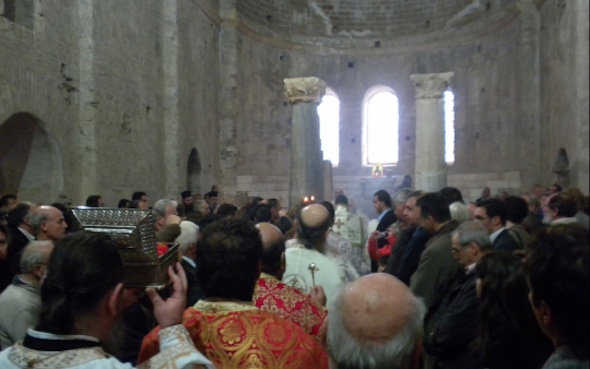
Hundreds of Orthodox Christians and other pilgrims descended on the village of Demre, Turkey, to the St. Nicholas Church where St. Nicholas served as the Bishop of Myra from 325-350 A.D.
The church still stands today, but has been destroyed and rebuilt several times. St. Nicholas was martyred here and buried under the church until his bones were stolen by Italians in 1087 and taken to Bari, Italy, where they remain.
“We’re lucky to still have this church intact,” said priest Vissarion Komezias, who was one of the celebrants at the 2009 celebration of St. Nicholas’ feast day, which is marked by Christians around the world on Dec. 6.
For the last three years, the Turkish government has allowed the Eastern Orthodox Church to once again celebrate a mass in Nicholas’ church. From 2002 to 2006, the Turkish government had organized its own “prayer for peace” instead.
During the 2009 liturgy given in both Greek and Turkish, celebrant Hrisostomos Kalaycı from the Istanbul Patriarchate thanked the Ministry of Culture and Tourism.
“The people of Anatolia have been famous since ancient times for their diligence, their faith in God’s orders, their honesty and modesty,” Kalayci said. “I pray to God for love and peace in our country. May St. Nicholas help us all.”
Kalayci, Komezias, and other priests from the Orthodox Church served the wall-to-wall crowd. Candles flickered against the crumbling walls of the more than 1,500-year-old church while pictures of John the Baptist, Jesus, Mary and child, and Saint Nicholas himself adorned the altar. The saint’s image was brought to the center where a candle and the bishop’s mitre (traditional headdress) rested beside it.
The crumbling pillars next to the altar symbolized the church’s tumultuous history that includes earthquakes and war. The church underwent several restorations including by the Romans in 1043, the Russians in the 19th century, and more recently with the assistance of the small Greek island of Megisti.
“Our people rebuilt this church,” said Megisti resident Evangelia Mavrothalassitis.
See all the latest news from Greece and the world at Greekreporter.com. Contact our newsroom to report an update or send your story, photos and videos. Follow GR on Google News and subscribe here to our daily email!




